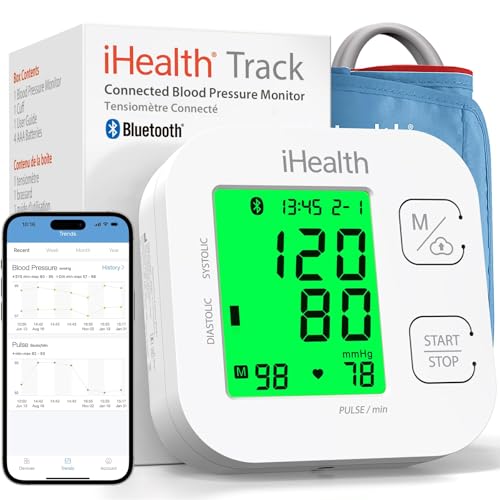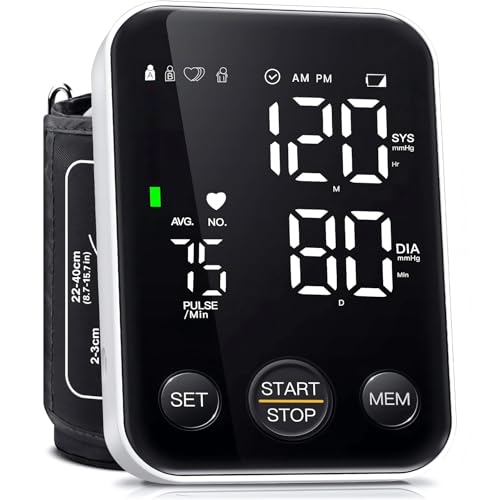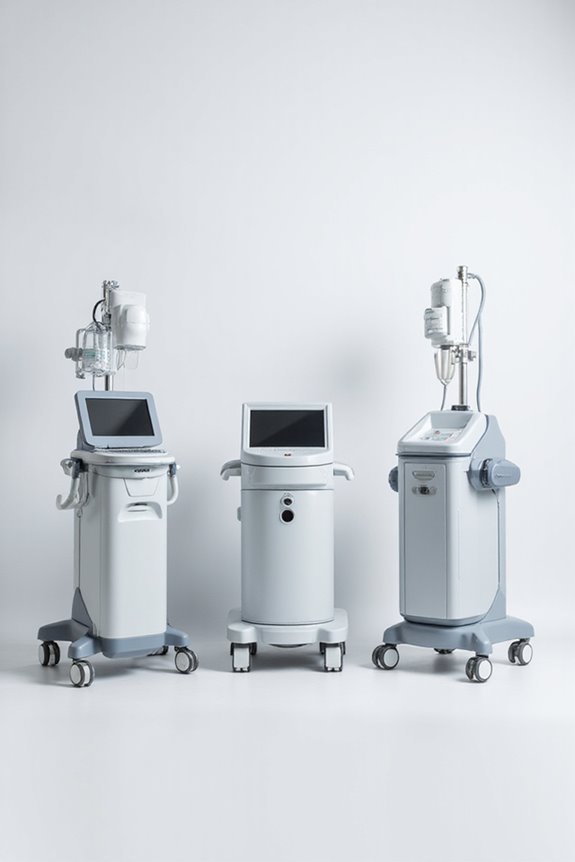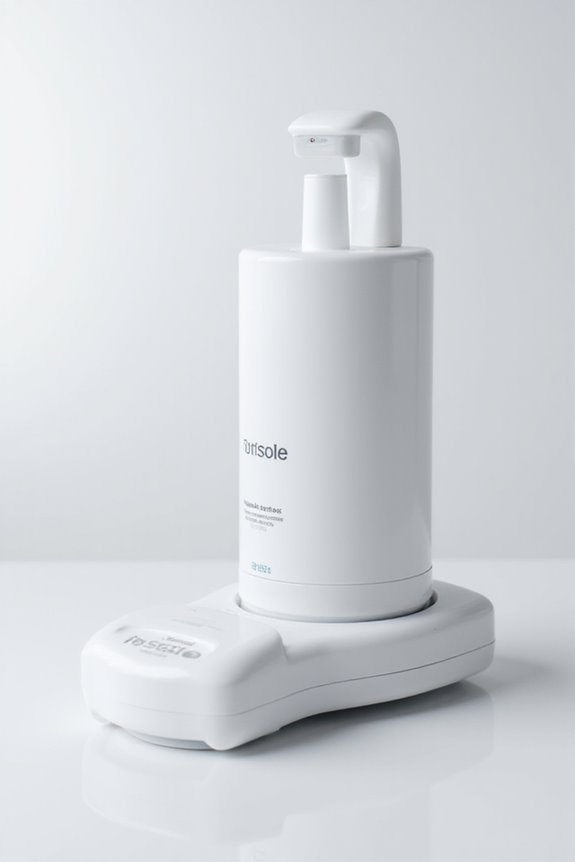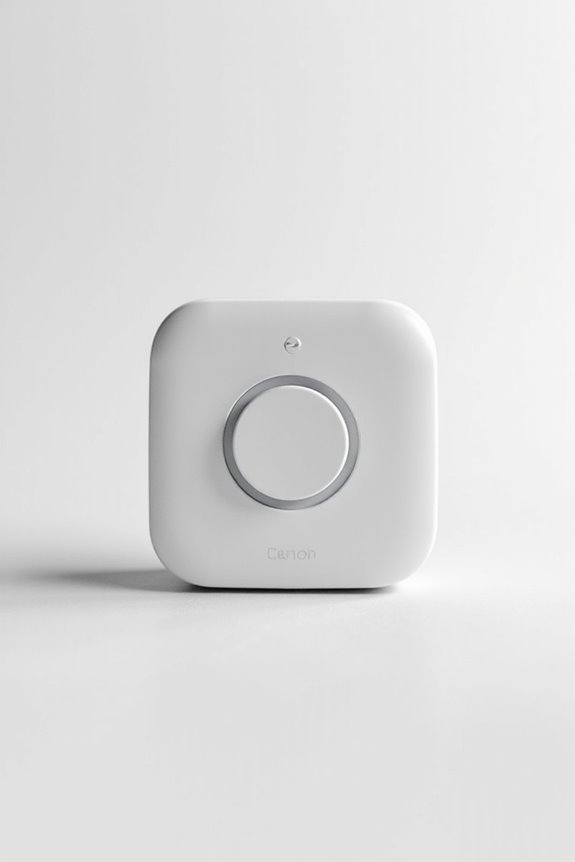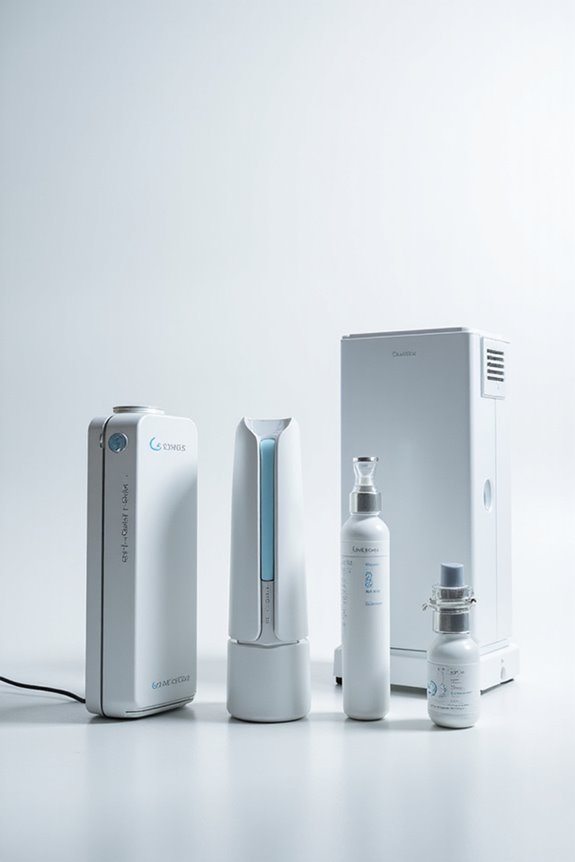As an Amazon Associate, we earn from qualifying purchases. Some links may be affiliate links at no extra cost to you. Although our opinions are based on curated research, we haven't used these products. Articles generated with AI.
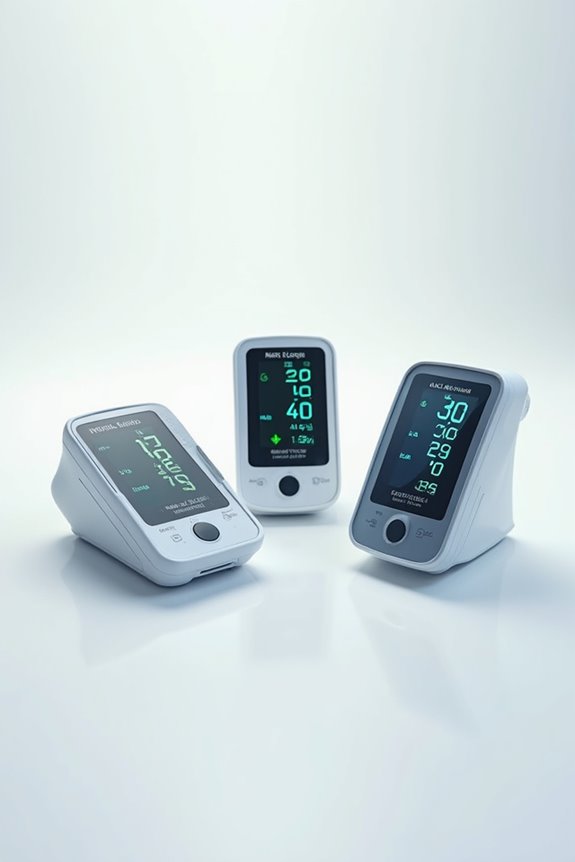
The 3 Best Rechargeable Blood Pressure Monitors of 2025 – Accurate and Convenient
The three best rechargeable blood pressure monitors of 2025 include:
- Automatic Upper Arm Monitor: Features a large display and user-friendly operations, fitting arm sizes from 9 to 17 inches.
- iHealth Track Monitor: Offers Bluetooth functionality, large multi-color display, and stores up to 99 readings on the device.
- Oklar Monitor: Equipped with a large LED display and extensive memory, it stores up to 240 readings for two users.
Explore additional features and considerations to find your ideal monitor.
Key Takeaways
- Look for blood pressure monitors with rechargeable batteries to enhance convenience and sustainability in home health management.
- Ensure monitors have clinically validated accuracy to provide reliable blood pressure readings essential for health monitoring.
- Opt for models with user-friendly designs, such as large displays and ergonomic features, to facilitate ease of use.
- Check for memory storage capabilities, allowing multiple users and extensive data tracking for effective chronic condition management.
- Consider Bluetooth compatibility to enable seamless app integration for tracking, analyzing readings, and sharing data with healthcare providers.
Blood Pressure Machine, Automatic Upper Arm Monitor with Large Screen
Blood Pressure Machine, Automatic Upper Arm Blood Pressure Monitor with 2x199 readout, 4.5 inch...
- Large Cuff: The large cuff ensures a comfortable fit for most adult users, providing accurate and reliable readings
- Battery Powered: Convenient and portable, this blood pressure monitor operates on batteries, allowing you to use it anywhere, anytime
- Automatic Operation: Easy to use with just one touch, this monitor automatically inflates the cuff and provides quick, precise readings
The Automatic Upper Arm Blood Pressure Monitor is particularly well-suited for individuals seeking an easy-to-use device for home health management.
Key Features:
- Display: Large 4.5-inch backlit screen enhances visibility.
- Cuff Size: Adjustable cuff fits arm circumferences from 9 to 17 inches.
- Memory Storage: Stores up to 199 readings for two users.
- Arrhythmia Detection: Monitors heart rhythm for added safety.
Operation:
- User-Friendly: One-touch operation with automatic cuff inflation.
- Power Supply: Can use batteries or USB-C cable.
Reliability:
– Accuracy: Consistently delivers reliable readings comparable to professional devices.
Best For: Individuals seeking a reliable and easy-to-use blood pressure monitor for home health management.
Pros:
- User-Friendly: One-touch operation and automatic cuff inflation make it accessible for anyone.
- Memory Storage: Can store readings for two users, facilitating better health tracking for couples or families.
- Accurate Readings: Delivers consistent results comparable to more expensive medical devices.
Cons:
- Cuff Size Limitations: The maximum cuff size may not accommodate all users, particularly those with larger arm circumferences.
- Potential Over-Reliance: Some users may become overly dependent on the device for monitoring.
- Limited Advanced Features: Lacks some advanced functionalities found in higher-end models, such as smartphone connectivity.
iHealth Track Smart Upper Arm Blood Pressure Monitor
Sale
iHealth Track Smart Upper Arm Blood Pressure Monitor with Wide Range Cuff That fits Standard to...
- Clinically Accurate: Easy Operation by two buttons, Advanced Accuracy, No Calibration required.
- Large Multi-Color Backlit Display: The large, oversized numbers make reading the results from this upper arm blood pressure monitoring device a breeze. Coded...
- Easy Management: Manage and track up to 99 readings on your blood pressure monitor and unlimited readings on your smartphone with iHealth's free iOS and Android...
For individuals seeking a reliable and user-friendly solution to monitor their blood pressure at home, the iHealth Track Smart Upper Arm Blood Pressure Monitor stands out as an excellent choice.
Product Features:
- Wide range cuff fits arms 8.7-16.5 inches (22-42 cm).
- Bluetooth compatibility with iOS (12.0 or later) and Android (9.0 or later).
- Clinically accurate; no calibration needed.
- Large multi-color backlit display with oversized numbers.
User Experience:
- Simple two-button operation.
- Comfortable cuff; suitable for standard to large arms.
- Stores up to 99 readings on the device; unlimited on the app.
Accuracy and Validation:
– Third-party clinically validated; consistent readings.
Best For: Individuals looking for an accurate, easy-to-use blood pressure monitor for home health management.
Pros:
- Convenient Bluetooth functionality allows for easy data syncing with iOS and Android devices.
- Large multi-color display ensures readability, making it user-friendly for those with vision issues.
- Clinically validated accuracy provides peace of mind for users monitoring their health.
Cons:
- Some users report connectivity issues with the iHealth app, affecting syncing speed.
- Specific measurement accuracy concerns for individuals with unique blood pressure needs.
- Limited two-button operation may be overly simplistic for users who prefer more features.
Oklar Blood Pressure Monitor for Home Use
Sale
Oklar Blood Pressure Monitor Upper Arm Monitors for Home Use BP Machine Sphygmomanometer with 2x120...
- One-Button Design: This Oklar blood pressure monitor features a one-button operation, making measurement easy and convenient; with just a touch, you can quickly take a...
- Large LED Display: The backlit LED screen with clear digits makes it easy for anyone to read quickly; you can get readings within 1 minute, and it's user-friendly for the...
- Stores Up to 240 Readings: Supports two users, storing 120 readings per user; this feature makes it easy to track and monitor blood pressure trends for you and your...
Oklar Blood Pressure Monitor for Home Use stands out as an ideal choice for individuals and families seeking reliable at-home monitoring.
Design and Usability
- One-button operation guarantees easy measurement.
- Compact design aids in storage and transport.
- Adjustable arm cuff accommodates 8.7 – 15.7 inches (22-40 cm).
- Includes a storage bag for organization.
Display Features
- Large LED display with backlight facilitates reading in low light.
- Clear digits cater to all ages, especially the elderly.
Memory and Tracking
- Stores up to 240 readings (120 per user) for two users.
- Effective for tracking blood pressure trends.
Best For: Individuals and families seeking a reliable and user-friendly blood pressure monitor for home use.
Pros:
- Large LED display with backlight for easy readability, even in low light conditions.
- One-button operation and adjustable arm cuff make it simple for users of all ages.
- Memory feature stores up to 240 readings, allowing for easy tracking of blood pressure trends.
Cons:
- Requires 3 AA batteries or a Type-C power supply for operation; adapter not included.
- Not rechargeable, which may be inconvenient for frequent users.
- May be less portable than some competitors due to its size and reliance on battery power.
Factors to Consider When Choosing a Rechargeable Blood Pressure Monitor
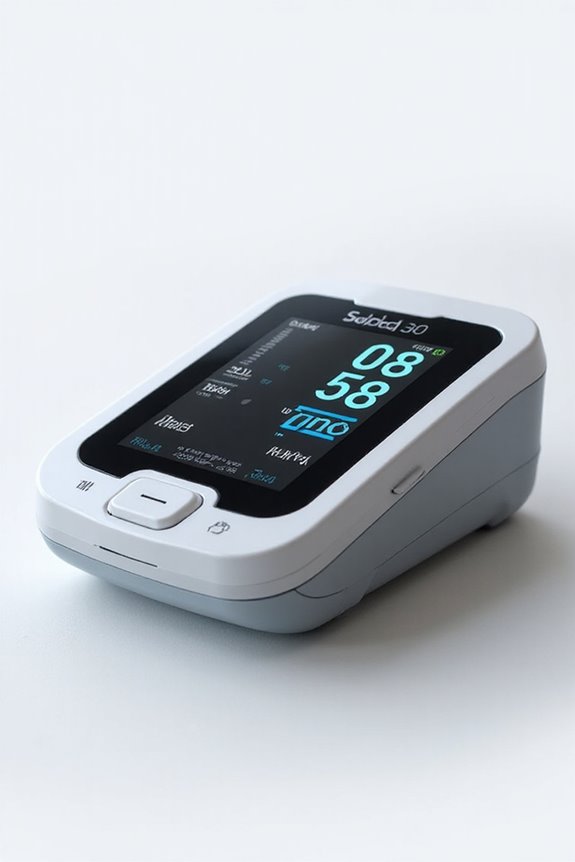
When choosing a rechargeable blood pressure monitor, you should consider several key factors. These include power source options, display readability, accuracy and calibration, cuff size compatibility, and data storage capacity. Evaluating these features will help you select a device that meets your specific needs for effective monitoring.
Power Source Options
Power source options are critical factors to evaluate when selecting a rechargeable blood pressure monitor. Consider the following:
- Charging Interface: Many models feature a USB-C interface, enhancing compatibility and reducing cord clutter.
- Battery Life: Review the battery life, as some monitors may demand more frequent charging based on usage frequency.
- Battery Type: Determine if the monitor has a built-in rechargeable battery or uses replaceable rechargeable batteries; this affects longevity and user convenience.
- Dual Power Options: Some monitors provide dual power capabilities, allowing operation with batteries or a direct power source. This feature offers increased flexibility for home and travel use.
Choosing the right power source can greatly impact your experience and the device’s performance.
Display Readability
How important is display readability when choosing a rechargeable blood pressure monitor?
Display readability is vital for accurate and efficient monitoring.
- Size: Look for a large display, ideally 4 inches or more, to aid users, especially older individuals or those with vision impairments.
- Backlit Displays: Guarantee visibility in low-light conditions, allowing you to read measurements anytime.
- Oversized Numbers: Facilitate quicker comprehension, reducing the chance of misinterpretation.
- Coded Displays: Consider models with color indicators (green, yellow, red) for immediate visual feedback on blood pressure status.
- Intuitive Layouts: Clear and streamlined layouts simplify operation, minimizing user confusion.
Prioritize these features to enhance your monitoring experience and understanding of your health.
Accuracy and Calibration
Accuracy and calibration are fundamental factors to evaluate when selecting a rechargeable blood pressure monitor.
- Accuracy: Verify the monitor’s readings align with clinical measurements. Look for devices that are clinically validated, confirming their reliability for home use.
- Calibration: Some monitors may require periodic calibration to maintain precision. Many modern devices are designed to minimize or eliminate the need for this.
- Additional Features: Consider monitors with arrhythmia detection capabilities, as they can enhance reading accuracy by identifying irregular heartbeats which may influence blood pressure results.
- Consistency: Pay attention to the consistency of readings over multiple tests. Tracking trends provides a better indication of accuracy compared to relying solely on single measurements.
Cuff Size Compatibility
When selecting a rechargeable blood pressure monitor, cuff size compatibility is an essential factor that directly impacts the accuracy of your readings.
A properly fitting cuff guarantees consistent and reliable measurements. Most cuffs fit arm sizes ranging from 8.7 to 17 inches. An ill-fitting cuff can lead to inaccurate readings, so confirming cuff size specifications is critical before purchase.
Consider these points:
- Look for monitors with adjustable cuffs to accommodate various arm sizes, enhancing usability for multiple users in a household.
- Verify that the cuff can fit all intended users, improving measurement accuracy.
- Some models may have limited options, so always check compatibility.
Prioritizing cuff size will contribute to effective monitoring and better health management.
Data Storage Capacity
Data storage capacity is a significant aspect to take into account in your choice of rechargeable blood pressure monitors.
- Reading Capacity: Some monitors can store up to 240 readings, accommodating multiple users.
- User Tracking: Many devices offer memory functions for two users, which is ideal for couples or families.
- Chronic Condition Management: A higher data capacity is essential for individuals managing chronic conditions, as it allows for better tracking of blood pressure trends over time.
- App Integration: Devices that sync with mobile apps may provide unlimited data storage, facilitating extensive analysis and monitoring.
App Integration Features
How important are app integration features when selecting a rechargeable blood pressure monitor?
App integration can greatly enhance your monitoring experience. Here are key benefits to take into account:
- Data Tracking: Apps let you track and store readings over time, revealing health trends and patterns.
- Bluetooth Syncing: Many monitors sync with mobile apps, providing convenient access and easy sharing of health data.
- Visualization: Advanced apps use color-coded displays for quick interpretation of readings.
- Reminders and Tracking: Features may include medication reminders and the ability to share data with healthcare providers.
- Enhanced Storage: Users can store more readings in the app than on the device itself, allowing for thorough monitoring over longer periods.
Frequently Asked Questions
How Often Should I Calibrate My Blood Pressure Monitor?
To guarantee accuracy, calibrate your blood pressure monitor every six to twelve months. Factors influencing frequency include:
- Manufacturer recommendations
- Changes in environmental conditions
- Your health status
If you notice discrepancies in readings compared to professional measurements, recalibration might be necessary. Regularly check the device’s battery and confirm it meets operational standards to maintain proper functioning. Accurate readings are vital for effective health monitoring.
What Is the Lifespan of a Rechargeable Blood Pressure Monitor?
The lifespan of a rechargeable blood pressure monitor typically ranges from 3 to 5 years. Factors affecting this duration include:
- Frequency of use: Regular use can shorten lifespan.
- Battery quality: Higher quality batteries last longer.
- Maintenance: Proper care enhances longevity.
Monitor performance may degrade over time, leading to inaccurate readings. It’s essential to regularly assess functionality and replace the device as needed to guarantee reliable blood pressure monitoring.
Can I Use These Monitors for Multiple Users?
Yes, you can use rechargeable blood pressure monitors for multiple users. However, features vary by model.
- Data Storage: Many monitors allow for multiple user profiles, storing each individual’s readings separately.
- Calibration Needs: Verify regular calibration for accuracy across users.
- Memory Capacity: Some models accommodate data for up to 99 readings per user.
Check the specifications for user profiles before purchase to confirm compatibility with your household’s needs.
Are There Specific Age Recommendations for Using These Monitors?
Age Recommendations for Blood Pressure Monitors:
- Generally, blood pressure monitors can be used for various age groups, including adults and children.
- For children, it’s essential to consult a healthcare provider to guarantee proper cuff size and technique.
- Adults over 60 often require more frequent monitoring due to age-related risks.
- Always adhere to manufacturer guidelines for specific age recommendations and instructions for use to guarantee accuracy and safety.
What Should I Do if My Readings Seem Inconsistent?
If your readings seem inconsistent, consider the following steps:
- Check Calibration: Verify the monitor is properly calibrated according to manufacturer guidelines.
- Consistent Timing: Measure your blood pressure at the same time each day.
- Rest Before Measuring: Sit quietly for 5 minutes prior to taking a reading.
- Arm Position: Keep your arm at heart level during measurement.
If discrepancies persist, consult a healthcare professional for further evaluation.


